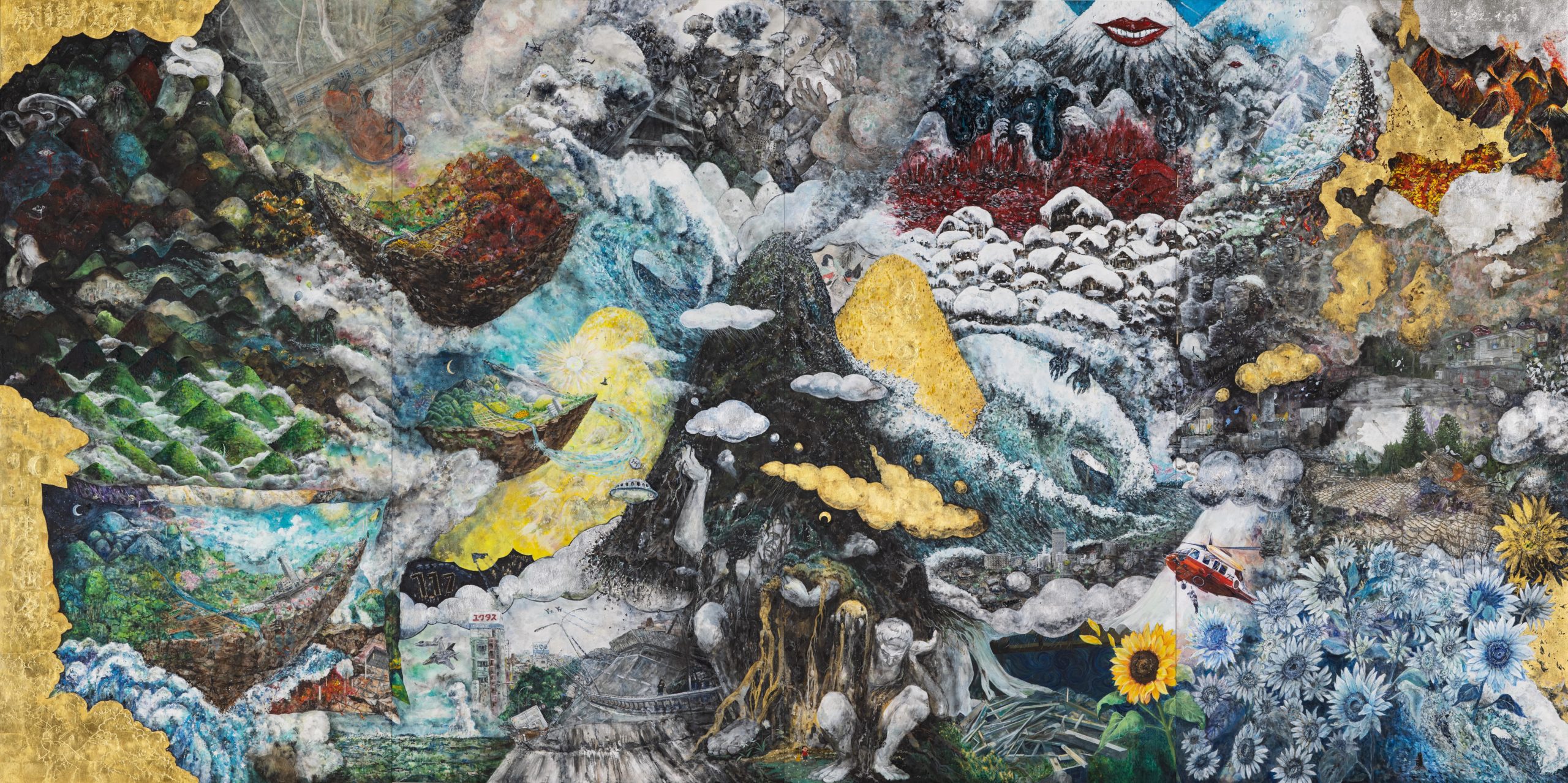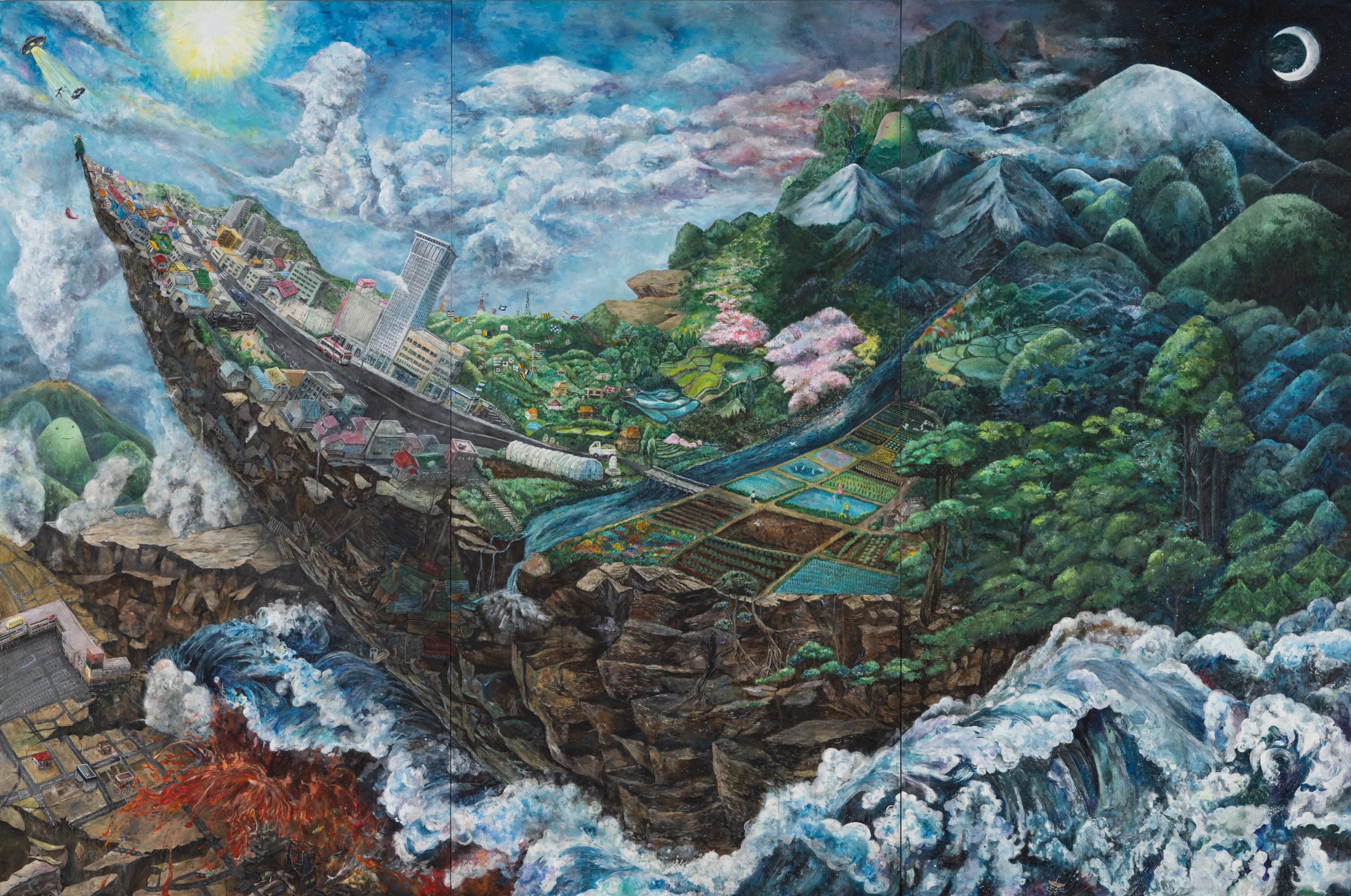「Is Tohoku-ga Possible? -Shōjōzeze (Timeless Existence)-」
July 8 – July 28, 2022
GALLERY HOURS :11:00 – 19:00
GALLERY CLOSED:
SUNDAYS, MONDAYS, PUBLIC HOLIDAYS
※This exhibition is now concluded.
Thank you to all the many people who stopped by.
Opening Artist Talk:
July 8, 2022 18:00 start
*Talk show is held in Japanese (no English translation)
※PLEASE NOTE THAT ENTRY MAY BE RESTRICTED IF THE NUMBER OF VISITORS EXCEEDS THE MAXIMUM CAPACITY.

While I was working at the studio in the woods, Takashi Murakami contacted me. “I saw the exhibition, ‘Is Tohoku-ga possible?’ at the Kyoto Kyocera Museum of Art, he said. “Can I come see you in Yamagata now?” In no time at all, a LINE group of about 10 people was formed, and the coordination of a ridiculously overcrowded schedule started on all fronts. The next evening, I saw Murakami’s silhouette getting off alone at the rustic Kaminoyamaonsen Station platform. As I showed him around my studio, which used to be an elementary school classroom, our dialogue continued late into the night.
“What is going to happen to this Tohoku-ga going forward?” “I hope it will eventually be housed in an art museum in Tohoku and get displayed in a permanent exhibition or something.” “What a fool! Museums don’t last forever!” “I am not interested in the concept of Tohoku-ga! But the artwork holds tremendous power!” “Without a concept, people wouldn’t gather and there wouldn’t be such a heated swell.” “You people are the least aware of the power of your artwork!”
Struck by his passionate and straightforward approach, we decided to produce a copy of Overlapped Tohoku Mountainscapes and Ark Plan, as well as a new collaborative work on commission.
This was the 10th anniversary milestone of the Great East Japan Earthquake, and I had also found out, to my shock, that Masatake Kozaki, my longtime work partner, was leaving university. So we decided to make “disaster” the theme for our latest collaborative work.
We established that the concept of “disaster,” which is predicated on the existence of human beings, is a force so great that it far exceeds the ability of an individual or group to cope with, and we soon decided on the direction of the production: We would create a patchwork of disasters that ranged from major catastrophes recorded in history to personal ones, such as heartbreak or separation from immediate family, based on the structure of Rakuchū Rakugai Zu (views in and around the city of Kyoto).
Soon after we started working on the painting, an eruption occurred at Nakadake of Mt. Aso, and after we discussed how war is a kind of disaster, the invasion of Ukraine took place. This collaborative work was born out of a sense of elation as if reality and the pictorial space were resonating with each other.
The title is “Shōjōzeze (Timeless Existence),” a concept in Buddhism that people are born and die and pass through an endless number of lifetimes. As an after-story of Yamagon’s journey to make this land defiled by the “Ark Plan” a place in which we can live again, the work is filled with strong desire to never forget this life and the next in perpetuity.
Natsunosuke Mise

方舟計画 令和手, 2022, Acrylic on canvas, 3000x4500mm.
Photo: Yu Kusanagi ©︎Is Tohoku-ga possible?
I was moved tremendously when I saw Is Tohoku-ga Possible?, a collaboration between Natsunosuke Mise, Masatake Kozaki, and students from Tohoku University of Art & Design, which was included in the exhibition “Heisei Bijutsu: Utakata to Gareki 1989-2019” curated by Noi Sawaragi. The work included a hanging map of Japan and a series of bold, impactful paintings, and I experienced a surge of emotions as if I had seen a strikingly powerful artwork of an art student. It had nothing to do with the concept-supremacy of contemporary art, and was instead filled with the conviction that the act of painting itself is the most important thing in art, which was refreshing.
Furthermore, the fact that I could relate to many aspects of the context that led to the naming of “Tohoku-ga” in terms of my career and the current I have been following may have also triggered my emotional reaction.
I am a graduate of the Nihon-ga Department of Tokyo University of the Arts, and have long had doubts about the department to which I belonged. When I heard the title “Tohoku-ga” proposed by Natsunosuke Mise, I immediately imagined that he, too, was one of the victims of the curse of the “Nihon-ga” departments in art universities, and that there was a correlation with “Kyushu-ha.”
To explain the curse of the Nihon-ga department, at the origin of Japanese art universities was Tenshin Okakura, who founded the first art university in Japan in the Meiji era with a strong will that Japan should spiritually reconstruct itself in the face of the Western powers. The curse is that the Nihon-ga department is therefore an indispensable element of a Japanese art university.
Even after Japan’s defeat in the Pacific War, Nihon-ga remained a stronghold in the hearts of the Japanese people, and its presence in Japanese society was enormous from the rise of the bubble economy to its peak, but it disappeared with the bursting of the bubble economy.
I will not go into the reasons of it here, but I believe that it was the generation of Mise that suffered the brunt of this collapse.
Mise is a graduate of the Nihon-ga Department of Kyoto City University of Arts, and I believe that he had been asking himself what Nihon-ga really means ever since he was a student there. Most likely, he was not able to find the answer, which must have felt like a huge setback. I supposed that the feeling of being lost may have eventually led him in the direction towards Tohoku-ga.
Next, the correlation with Kyushu-ha.
Kyushu-ha was a movement led by war orphan Mokuma Kikuhata, born and raised in northern Kyushu, with with other aspiring artists in Kyushu, that challenged the capital-centered, empty, authoritative behavior of postwar Tokyo, and it is thought to have been rooted in doubts about the state of the Japanese nation after the defeat in the war.
I believe that Tohoku-ga was named in the same sense that Kyushu-ha was named as an absolute rejection of the hierarchical relationship between the central and rural regions, which had little basis, and with a touch of sadness and self-deprecation regarding the decline of Nihon-ga. I sympathized greatly with this context.
Another point of empathy for me was that the Tohoku-ga artworks are group work, with Mise and Konozaki wielding the conductor’s baton and bringing together many people to create the works. Their work was being produced under the exact same structure as that of the projects in which Mokuma Kikuhata, the leader of the Kyushu-ha, had his base at an art school and collaborated with students to enlarge the paintings of Sakubei Yamamoto, a coal miner.
Along with his journey in search of Japan, he came to terms with his own life and moved to the Tohoku, and a year into his work on the paintings based on the region, the project was met with the Great East Japan Earthquake a year after its start.
For more details, please read the commentary from the artist himself.
When I look at this body of works in that context, I am besieged by a strange feeling that I can see the distortion of Japan itself. I wanted to own the work, but Mise really wanted to leave it in Tohoku. So I proposed that they reproduce the work if they cannot sell it. He agreed to it, and this is how the work for this show came to completion.
I wanted to collect such work. Alternatively, I thought it might also be good for an overseas collector or a museum to have it, and that is why I ordered the reproduction.
I thought it would be best if the artists themselves, their friends, and those who collaborated with them did as they pleased, and they wanted to present the work in Japan first, so I decided to create a an occasion to exhibit it.
As such, this exhibition is a bit unusual for our space, but I hope it will give some hope to Nihon-ga artists at art universities scattered throughout Japan.
TakashiMurakami

東北八重山景 令和手, 2022, Acrylic on canvas, 3000x4500mm.
Photo: Yu Kusanagi ︎©︎Is Tohoku-ga possible?
As precautionary measures to help contain the further spread of COVID-19, visitors are asked to wear masks and sanitize their hands before entering the gallery.
(Hand sanitizer is available at the entrance. Visitors without masks will be refused entry.)
Please refrain from visiting the gallery if you have any symptoms such as fever or cough.
Our staff will also adopt frequent hand sanitation and wear masks. The gallery will be routinely ventilated and high-touch areas will be regularly disinfected.
*Please check our website or Instagram for the latest information regarding opening hours, as the gallery schedule is subject to abrupt change due to unpredictable circumstances.
Thank you for your cooperation and understanding.